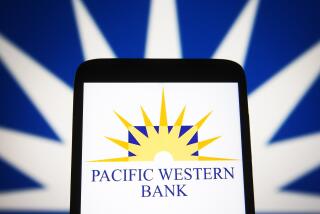Airline Angry at Plan to Sell Pan Am Routes
WASHINGTON — An attorney representing Northwest Airlines warned Monday that the carrier might pull out of the Far East if the Transportation Department approves the proposed sale of Pan American World Airways’ Pacific routes to United Airlines.
Pleading Northwest’s case during Transportation Department hearings, Ronald D. Eastman said the proposed sale would “result in a radical change in the structure of the Pacific (airline business).”
He told the agency that approval “would throw Northwest into chronic unacceptable profitability levels in the Pacific. The only rational choice is to retrench or withdraw from the market altogether.”
Such a threat, if carried out, could have a major competitive impact on the transpacific airline market because Northwest (which uses the name of Northwest Orient on its aircraft) is the largest U.S. carrier in the Pacific.
$55-Million Profit
Pan Am’s Pacific division, with revenues of $778 million and an annual profit of $55 million in 1984, is second. United announced in April that it would acquire the division for $750 million.
The Transportation Department has said it would render its final decision on Oct. 31.
Although Eastman said after the hearing that his words should be taken at face value, analysts and competitors said Northwest’s threat was meant purely to put pressure on the agency to turn down the acquisition.
“To me it is an idle threat,” said Robert Joedicke, analyst for Shearson Lehman Bros. “It is an irresponsible corporate implication.” He said Northwest just last week ordered three additional 400-passenger Boeing 747-200 jets.
The Justice Department, in a brief filed last week, contended that the Pan Am-United transaction would substantially reduce competition between the United States and Tokyo.
It suggested that the Transportation Department require the spinoff of a route between Tokyo and Seattle, Los Angeles or San Francisco. Without such a sale, the deal would be in violation of federal antitrust laws and should be denied, the Justice Department urged.
However, William Wagner, a public counsel representing the Transportation Department, said the transaction should be approved without forcing a route spinoff. He said the Pacific division sale may lower fares in Pacific markets and would improve Pan Am’s financial condition. This would enable the carrier to compete more effectively across the Atlantic and in Latin America, he said.
“There will be no significant reduction in competition,” he said. “And the effect on fares will be minimal.”
High Payment?
However, Wagner represents only consumer interests in this case and does not participate in the decision-making process, a Transportation Department spokesman said. Thus, his testimony should not be interpreted as a department endorsement of the sale, the spokesman said. The final decision, he said, rests with Transportation Secretary Elizabeth Hanford Dole.
Jonathan C. Rose, an attorney representing Eastern Airlines, said United was overpaying for the Pan Am operations. He said that of the $750-million price, only $366 million is the value of the assets and the rest represents the value of the routes. He contended that some of the planes included in the sale are old and inefficient.
“Pan Am is dumping a lot of unusable equipment on United Airlines and United will put it into the Far East,” he said. He added that Eastern would like to buy any Tokyo route that might be dropped by United--if the Transportation Department required it--and said he thought Eastern could make money from such operations.
Charles Miller, an outside attorney representing United, said competition would not suffer and fares would decline if the transaction was approved. He said that, once the routes were transferred to United, it would expand them with resulting “lower cost to the consumer.”
Former Transportation Secretary William T. Coleman Jr., now a Pan Am director who represented the firm at the hearing, said Pan Am was selling the routes in part because it “could no longer be a carrier all over the world. It was a business decision to sell the Pacific division and to emphasize the Atlantic and Latin America.”
More to Read
Inside the business of entertainment
The Wide Shot brings you news, analysis and insights on everything from streaming wars to production — and what it all means for the future.
You may occasionally receive promotional content from the Los Angeles Times.








